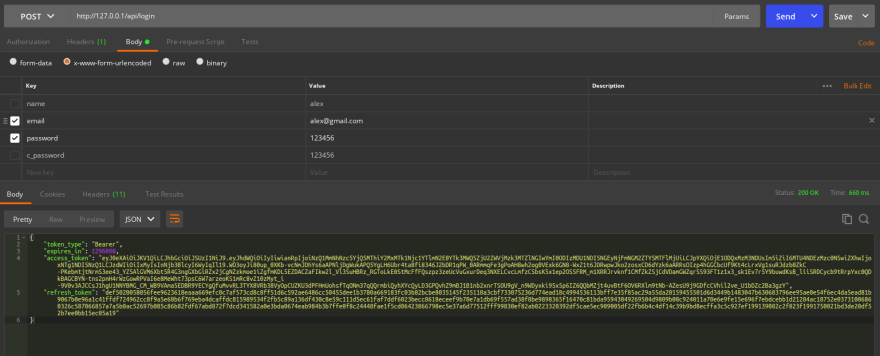Create API Rest with Laravel 7.X Passport Authentication And Implement Refresh Token (Part 1)

Mohammad Reza
Posted on March 13, 2020

you can find the newer article about this in here
Step 1. Install Laravel
With this command we install laravel
laravel new website
Step 2. Install Laravel Passport Package And Guzzle
Laravel Passport provides a full OAuth2 server implementation
composer require laravel/passport
composer require guzzlehttp/guzzle
composer require symfony/psr-http-message-bridge
Step 3. Run These Commands For Fixing Storage Permission
sudo chown -R $USER:www-data storage
sudo chmod -R 775 storage
Step 4. Run Migration
Create the tables that your application needs to store clients and access tokens
php artisan migrate
Step 5. Generate keys
With this commend you create "personal access" and "password grant" that you need them for generating access tokens
php artisan passport:install
Step 6. Add Trait To User Class
There are some helper functions in this trait
<?php
namespace App;
use Illuminate\Notifications\Notifiable;
use Illuminate\Foundation\Auth\User as Authenticatable;
use Laravel\Passport\HasApiTokens;class User extends Authenticatable #chenged
{
use Notifiable, HasApiTokens; #changed
...
Step 6. Call Passport Routes And Add Some Configs
call the Passport::routes method within the boot method of your AuthServiceProvider and change the token life time like this
<?php
namespace App\Providers;
use Illuminate\Foundation\Support\Providers\AuthServiceProvider as ServiceProvider;
use Illuminate\Support\Facades\Gate;
use Laravel\Passport\Passport;
use Carbon\Carbon;
class AuthServiceProvider extends ServiceProvider
{
/**
* The policy mappings for the application.
*
* @var array
*/
protected $policies = [
// 'App\Model' => 'App\Policies\ModelPolicy',
];
/**
* Register any authentication / authorization services.
*
* @return void
*/
public function boot()
{
$this->registerPolicies();
Passport::routes();
Passport::tokensExpireIn(Carbon::now()->addDays(1));
Passport::refreshTokensExpireIn(Carbon::now()->addDays(10));
}
}
Step 7. Finally You Need To Change The Api Driver
you need change api drive in config/auth.php like this
'guards' => [
'web' => [
'driver' => 'session',
'provider' => 'users',
],
'api' => [
'driver' => 'passport',
'provider' => 'users',
],
],
Step 8. Create api route
<?php
use Illuminate\Support\Facades\Route;
Route::post('login', 'UserController@login');
Route::post('register', 'UserController@register');
Step 9. Create controller
php artisan make:controller UserController
Step 10. Complete the controller
<?php
namespace App\Http\Controllers;
use App\User;
use Validator;
use Exception;
use GuzzleHttp\Client;
use Illuminate\Http\Request;
use Illuminate\Support\Facades\Auth;
use Laravel\Passport\Client as OClient;
class UserController extends Controller
{
public $successStatus = 200;
public function login() {
if (Auth::attempt(['email' => request('email'), 'password' => request('password')])) {
$oClient = OClient::where('password_client', 1)->first();
return $this->getTokenAndRefreshToken($oClient, request('email'), request('password'));
}
else {
return response()->json(['error'=>'Unauthorised'], 401);
}
}
public function register(Request $request) {
$validator = Validator::make($request->all(), [
'name' => 'required',
'email' => 'required|email|unique:users',
'password' => 'required',
'c_password' => 'required|same:password',
]);
if ($validator->fails()) {
return response()->json(['error'=>$validator->errors()], 401);
}
$password = $request->password;
$input = $request->all();
$input['password'] = bcrypt($input['password']);
$user = User::create($input);
$oClient = OClient::where('password_client', 1)->first();
return $this->getTokenAndRefreshToken($oClient, $user->email, $password);
}
public function getTokenAndRefreshToken(OClient $oClient, $email, $password) {
$oClient = OClient::where('password_client', 1)->first();
$http = new Client;
$response = $http->request('POST', 'http://mylemp-nginx/oauth/token', [
'form_params' => [
'grant_type' => 'password',
'client_id' => $oClient->id,
'client_secret' => $oClient->secret,
'username' => $email,
'password' => $password,
'scope' => '*',
],
]);
$result = json_decode((string) $response->getBody(), true);
return response()->json($result, $this->successStatus);
}
}
Step 11. Now lets test it
php artisan serve
Step 12. It works like a charm
You first need to register like this
And then you can register and give your tokens again
In the next parts we will make some private routes that need token, handle the exceptions and implement refresh token scenario
Create API Rest with Laravel 7.X Passport Authentication And Implement Refresh Token (Part 2)

Posted on March 13, 2020
Join Our Newsletter. No Spam, Only the good stuff.
Sign up to receive the latest update from our blog.




